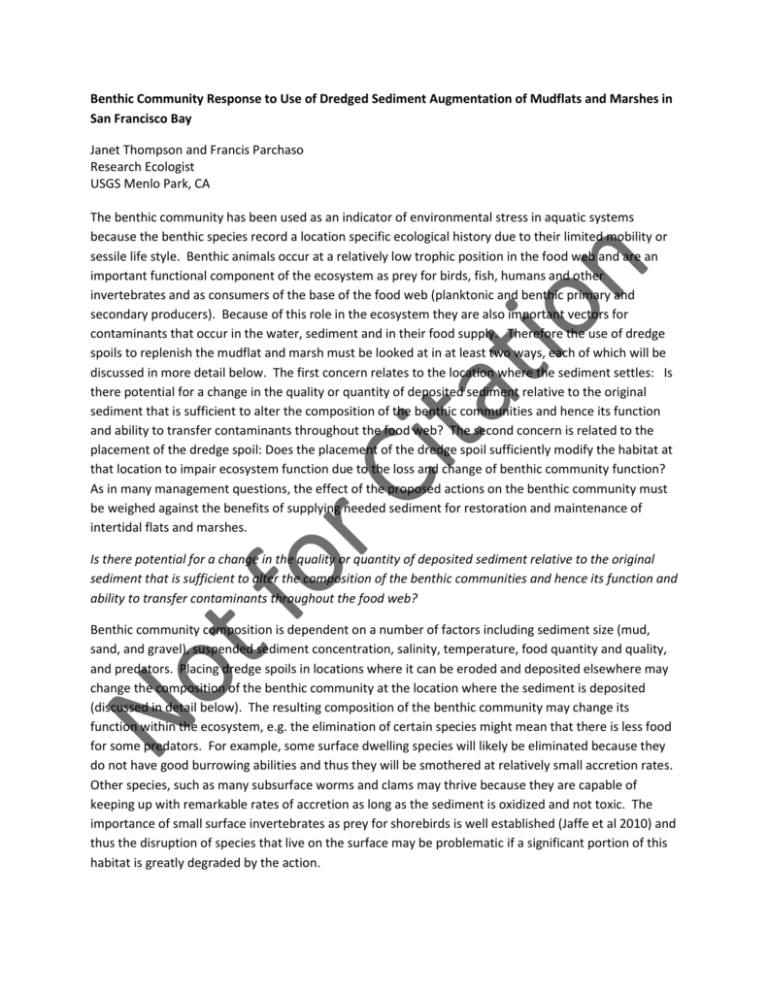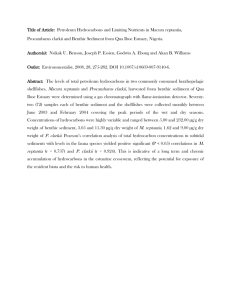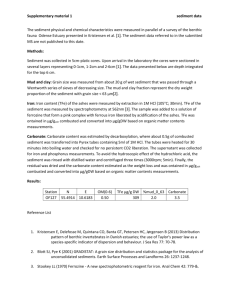BenthicCommunityConsiderations4InBayPlacement
advertisement

Benthic Community Response to Use of Dredged Sediment Augmentation of Mudflats and Marshes in San Francisco Bay Janet Thompson and Francis Parchaso Research Ecologist USGS Menlo Park, CA The benthic community has been used as an indicator of environmental stress in aquatic systems because the benthic species record a location specific ecological history due to their limited mobility or sessile life style. Benthic animals occur at a relatively low trophic position in the food web and are an important functional component of the ecosystem as prey for birds, fish, humans and other invertebrates and as consumers of the base of the food web (planktonic and benthic primary and secondary producers). Because of this role in the ecosystem they are also important vectors for contaminants that occur in the water, sediment and in their food supply. Therefore the use of dredge spoils to replenish the mudflat and marsh must be looked at in at least two ways, each of which will be discussed in more detail below. The first concern relates to the location where the sediment settles: Is there potential for a change in the quality or quantity of deposited sediment relative to the original sediment that is sufficient to alter the composition of the benthic communities and hence its function and ability to transfer contaminants throughout the food web? The second concern is related to the placement of the dredge spoil: Does the placement of the dredge spoil sufficiently modify the habitat at that location to impair ecosystem function due to the loss and change of benthic community function? As in many management questions, the effect of the proposed actions on the benthic community must be weighed against the benefits of supplying needed sediment for restoration and maintenance of intertidal flats and marshes. Is there potential for a change in the quality or quantity of deposited sediment relative to the original sediment that is sufficient to alter the composition of the benthic communities and hence its function and ability to transfer contaminants throughout the food web? Benthic community composition is dependent on a number of factors including sediment size (mud, sand, and gravel), suspended sediment concentration, salinity, temperature, food quantity and quality, and predators. Placing dredge spoils in locations where it can be eroded and deposited elsewhere may change the composition of the benthic community at the location where the sediment is deposited (discussed in detail below). The resulting composition of the benthic community may change its function within the ecosystem, e.g. the elimination of certain species might mean that there is less food for some predators. For example, some surface dwelling species will likely be eliminated because they do not have good burrowing abilities and thus they will be smothered at relatively small accretion rates. Other species, such as many subsurface worms and clams may thrive because they are capable of keeping up with remarkable rates of accretion as long as the sediment is oxidized and not toxic. The importance of small surface invertebrates as prey for shorebirds is well established (Jaffe et al 2010) and thus the disruption of species that live on the surface may be problematic if a significant portion of this habitat is greatly degraded by the action. Placing a berm near the flat or marsh edge would likely change the rate of delivery and the quality and character of the sediment which would result in the following consequences. Assuming the sediment delivery rate is within the range that the the animals can sustain a position relative to the surface and can still feed, the chronic stress on the animals resulting from increased, sustained activity needed to keep up with the sediment might reduce growth rates and therefore reduce their value as prey. For example, filter-feeding bivalves must process any suspended inorganic material in addition to the organic material when they filter the water. The increased cost of processing defines a maximum suspended sediment level beyond which a species will not feed (Bricelj and Malouf 1984). The duration and concentration of suspended sediment will therefore determine species-specific thresholds and the potential for loss of ecosystem function by this group of animals. Dredged material is rarely of the same grain size as that found in the shallow water based on the hydrodynamics; deeper channels are more likely to have coarser grain sizes due to the higher velocities found in the channel relative to the flats. Should this sediment be distributed over the intertidal flats we might see a change in benthic species composition as some species need fine sediment to build their tubes. Similarly, surface deposit feeding species may find the larger grain size carry less bacterial biomass, one of their food sources, and the larger size of particle may exceed the animal’s ability to consume the sediment. Experiments show this shift in particle size and subsequent shift in the benthic community with dredge spoils placed in the subtidal region with the plan that they would be naturally eroded and accreted, as is being suggested here, in North Carolina (Bishop et al. 2006). If the new sediment is contaminated we might see changes in the community as sensitivity to contaminants is species specific. Those species that survive the contamination may accumulate the toxins and pass them on to their predators. This is of particular concern with contaminants such as PCB’s that adhere to sediment (Fuchsman et al. 2006). At the higher rates of sedimentation we might expect to see smothering and death as described below. Does the placement of the dredge spoil sufficiently modify the habitat at that location to impair ecosystem function due to the loss and change of benthic community function? Any animals in or on the sediment where the berm is placed will be buried and die except possibly near the edges of the berm. The turbulence and erosion of the berm surface will likely preclude most species from colonizing the berm so it should not be treated as a functioning benthic community habitat unless the berm is never added to after its initial placement. Answering this question requires knowledge of the area of the habitat covered by the berm, relative to the area available and needed for the ecosystem function that is being impaired. This may be difficult to achieve as many habitats are poorly mapped in the system and we do not know total area of most habitat types. Areas that function as habitat for prey for fish are poorly understood in this system. We understand more about bird predation in some parts of the system as noted in Jaffe et al. 2010. Once the berm is gone we would expect the benthic community to return at a rate determined by dispersal and colonization rates of the important species and the toxicity and oxygen content of the sediment: see Nichols and Thompson 1986 for an example of the slow return of the benthic community in south San Francisco Bay mudflat following the smothering of the mudflat with dead, rafting macroalgae. Literature Cited Bishop MJ, CH Peterson, HC Summerson, HS Lenihan, JH Grabowski. 2006. Deposition and long-shore transport of dredge spoils to nourish beaches: impacts on benthic infauna of an ebb-tidal delta. J. Coastal Research 22(3):530-543. Bricelj VM and RE Malouf. 1984. Influence of algal and suspended sediment concentrations on the feeding physiology of the hard clam Mercenaria mercenaria. Marine Biology 84(2): 155-165. Fuchsman PC, Barber TR, Lawton JC, Leigh KB. 2006. An evaluation of cause-effect relationships between polychlorinated biphenyl concentrations and sediment toxicity to benthic invertebrates. Environ Toxicol Chem 25:2601-2612. Jaffe BE, JY Takekawa, LE Shaskey, AC Foxgrover. 2011. Climate-driven geomorphic alteration of intertidal habitats for foraging migratory birds in the San Francisco Bay estuary: a California landscape conservation cooperative project. Unpublished Data Summary Report to the U.S. Fish and Wildlife Service California Landscape Conservation Cooperative, Vallejo and Santa Cruz, California. 70pp. Nichols FH, JK Thompson. 1985. Persistence of an introduced mudflat community in South San Francisco Bay, California. Mar. Ecol. Prog. Ser.: 24:83-97








